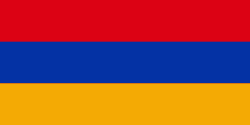Roman Armenia (Armenia)
Roman Armenia refers to the rule of parts of Greater Armenia by the Roman Empire, from the 1st century AD to the end of Late Antiquity. While Armenia Minor had become a client state and incorporated into the Roman Empire proper during the 1st century AD, Greater Armenia remained an independent kingdom under the Arsacid dynasty. Throughout this period, Armenia remained a bone of contention between Rome and the Parthian Empire, as well as the Sasanian Empire that succeeded the latter, and the casus belli for several of the Roman–Persian Wars. Only in 114 was Emperor Trajan able to conquer and incorporate it as a short-lived Roman province.
In the late 4th century, Armenia was divided between Rome and the Sasanians, who took control of the larger part of the Armenian Kingdom and in the mid-5th century abolished the Armenian monarchy. In the 6th and 7th centuries, Armenia once again became a battleground between the East Romans (Byzantines) and the Sasanians, until both powers were defeated and replaced by the Muslim Caliphate in the mid-7th century.
Following the fall of the Artaxiad dynasty after Pompey's campaign in Armenia in 66 BC, the Kingdom of Armenia was often contested between the Roman Empire and the Parthian Empire during the Roman–Parthian Wars. Throughout most of its history during this period, under the reign of the Arsacid Dynasty, the Armenian nobility was divided among Roman-loyalists, Parthian-loyalists, and neutrals.
Armenia often served as a client state or vassal at the frontier of the two large empires and their successors, the Byzantine and Sassanid empires. During the Byzantine–Sasanian wars, Armenia was ultimately partitioned into Byzantine Armenia and Sasanian Armenia.
In the late 4th century, Armenia was divided between Rome and the Sasanians, who took control of the larger part of the Armenian Kingdom and in the mid-5th century abolished the Armenian monarchy. In the 6th and 7th centuries, Armenia once again became a battleground between the East Romans (Byzantines) and the Sasanians, until both powers were defeated and replaced by the Muslim Caliphate in the mid-7th century.
Following the fall of the Artaxiad dynasty after Pompey's campaign in Armenia in 66 BC, the Kingdom of Armenia was often contested between the Roman Empire and the Parthian Empire during the Roman–Parthian Wars. Throughout most of its history during this period, under the reign of the Arsacid Dynasty, the Armenian nobility was divided among Roman-loyalists, Parthian-loyalists, and neutrals.
Armenia often served as a client state or vassal at the frontier of the two large empires and their successors, the Byzantine and Sassanid empires. During the Byzantine–Sasanian wars, Armenia was ultimately partitioned into Byzantine Armenia and Sasanian Armenia.
Map - Roman Armenia (Armenia)
Map
Country - Armenia
 |
 |
| Flag of Armenia | |
Armenia is a unitary, multi-party, democratic nation-state with an ancient cultural heritage. The first Armenian state of Urartu was established in 860 BC, and by the 6th century BC it was replaced by the Satrapy of Armenia. The Kingdom of Armenia reached its height under Tigranes the Great in the 1st century BC and in the year 301 became the first state in the world to adopt Christianity as its official religion. The ancient Armenian kingdom was split between the Byzantine and Sasanian Empires around the early 5th century. Under the Bagratuni dynasty, the Bagratid Kingdom of Armenia was restored in the 9th century. Declining due to the wars against the Byzantines, the kingdom fell in 1045 and Armenia was soon after invaded by the Seljuk Turks. An Armenian principality and later a kingdom Cilician Armenia was located on the coast of the Mediterranean Sea between the 11th and 14th centuries.
Currency / Language
| ISO | Currency | Symbol | Significant figures |
|---|---|---|---|
| AMD | Armenian dram | Ö | 2 |
| ISO | Language |
|---|---|
| HY | Armenian language |















